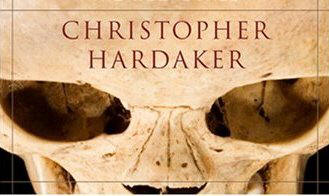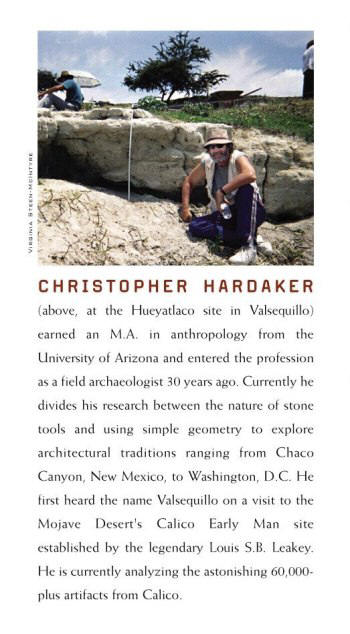 THE
FIRST AMERICAN
THE
FIRST AMERICAN
 THE
FIRST AMERICAN
THE
FIRST AMERICAN

THE SUPPRESSED STORY OF
THE PEOPLE WHO DISCOVERED
THE NEW WORLD

FOREWORD
THIS IS A BOOK ABOUT OUR KNOWLEDGE OF EARLY MAN.
THERE ARE TWO SUBPLOTS: EARLY MAN IN THE OLD WORLD AND
EARLY MAN IN THE NEW WORLD.
Much is known about Early Man in the Old World, where new discoveries continue to expand our knowledge base. Unfortunately, in the New World our knowledge is largely limited to Clovis and younger cultures. The study of potential pre-Clovis sites is not encouraged, and those who report a possible pre-Clovis site do so at significant risk to their career. An important part of this book reviews what is known about an Early Man site along the shore of Valsequillo Reservoir south of Puebla in central Mexico. It is a fascinating tale with a lot of data--which are accepted by most geologists and not accepted by most archaeologists.
As a scientist I am embarrassed that it has taken over thirty years for archaeologists and geologists to revisit the bone and artifact deposits of the Valsequillo Reservoir. In the late 1960’s and early 1970’s, data were presented that suggested Early Man had been in the New World much earlier than anyone had previously thought. Rather than further investigate the discoveries, which is what should have been done, they were buried under the sands of time, in the hope that they would be forgotten. My idea of science is to investigate anomalous data and hopefully learn something new. Unfortunately, the “Clovis First” mentality was so ingrained in North American archaeology that no further work was undertaken.
My first contact with the bone and artifact deposits of the Valsequillo Reservoir came in the early 1970’s, when I was asked if I would date zircons from some tephra units (layers of volcanic pumice and ash) that overlay the artifact-bearing beds. I agreed to take on the study as I was aware of the controversy regarding the age of the site. At the time I was sharing an office with Barney Szabo, the geochemist who had provided the uranium series dates that started the controversy. His ages suggested that the artifact beds were in excess of 200,000 years old. This did not sit well with the archeologist in charge of the project. The original paper by Szabo, Malde, and Irwin-Williams (1969, Earth and Planetary Science Letters, v. 6, p. 237-244) sets the stage for the controversy--geochronology versus archaeology. This is the only paper of which I am aware where one coauthor submits a rebuttal in the midst of an otherwise straightforward scientific paper.


Additional data suggesting an old age for the deposits came shortly after the Szabo paper. Virginia Steen-McIntyre, while studying the characteristics of the overlying tephra units, discovered two things that suggested an old age. While neither of the techniques she used provides a direct age in years, the results can be compared with similar material of known age and thus an age for the unknown deposits can be inferred. She found that hypersthene crystals in the tephras were deeply etched. Rather than being pristine, well-formed crystals, they looked more like a picket fence. Hypersthene crystals from a 24,000-year-old tephra in a similar climatic environment elsewhere in Mexico displayed minimal evidence of etching, suggesting that the age of the Valsequillo tephras is greatly in excess of 24,000 years. Her second piece of evidence is from tephra-hydration dating, based on the amount of water absorbed by the volcanic glass shards in the tephras. When volcanic glass shards form, they typically contain minute gas bubbles. With time the glass gradually absorbs water. The greater the amount of water in the glass, the older is its age. Eventually, the gas bubble cavities begin to fill with water. This is known a superhydration. Bubble cavities in the two Valsequillo tephra layers that could be dated by this method contain water. Comparison of the percentage of water in the bubble cavities to the percentage in tephras of known age suggests an age of about 250,000 years for the Valsequillo tephras. Thus by the time I got my zircons to date, three lines of evidence suggested that these deposits are greater than 200,000 years old.
I determined fission-track ages on zircons from two of the tephra units overlying the artifact beds. The Hueyatlaco ash yielded a zircon fission-track age of 370,000 ± 200,000 years and the Tetela brown mud yielded an age of 600,000 ± 340,000 years. There is a 96% chance that the true age of these tephras lies within the range defined by the age and the plus or minus value. Now, there were four different geological dating techniques that suggested a far greater antiquity to the artifacts than anyone in the archaeological community wanted to admit.
Virginia Steen-McIntyre presented all of the results on the geology and age of the deposits at a symposium on New World archaeological geology in 1973. The following quote from a summary of the conference (Geology, 1974, p. 77) has been on my wall ever since: “C. Irwin-Williams, who did the original archaeologic work, believes that such a great age is virtually impossible, and that sources of error must be sought in the dating methods.”
With the exception of a few papers by Virginia Steen-McIntyre in the geological literature, the unique and exciting discovery of an old Early Man site in North America ceased to exist. In my mind this is where the scientific method failed. There were geologic indicators that someone had been here 200,000 or more years ago. Unfortunately the existing paradigm was that no one preceded the Clovis culture to the Americas and that it was a waste of time and resources to even look for pre-Clovis sites. Through the scientific method of investigating the world around us, many paradigms have come and gone, being replaced with newer ones: such as, the earth and other planets circle the sun, the earth is spherical, the continents have drifted, and evolution explains the great diversity of species. The idea of Clovis being the first New World culture needs to be tested, not just accepted.
I was pleasantly surprised a few years ago when I learned that Marshall Payn was going to revisit the Valsequillo deposits. A lot of new and exciting data have come from this renewed interest. Perhaps the most exciting are the data presented by Sam VanLandingham on diatoms (microscopic fossils) from within the artifact beds and overlying (younger) beds. He finds species of diatoms that became extinct about 80,000 years ago. That is another piece of geological evidence that indicates an old age for these deposits.
So now we have at least five independent geological age estimates that all indicate an old, pre-Clovis age for the Valsequillo site.
The factors that affect the accuracy of each of these techniques are so different that it is highly unlikely that all five techniques could fortuitously significantly overestimate the age. One of my colleagues always tried to interpret geological processes using the principal of “Occam’s Razor”--the simplest explanation is usually correct. In this case we have the choice of accepting the results of five independent geological techniques as correct and concluding that the artifacts are greater than 200,000 years old or, alternatively, arguing that, for very different reasons, there is something significantly wrong with each of the geological age estimates.
I think that the readers of this book will find that the Clovis First paradigm is listing badly and quite possibly has sunk against the rocks of renewed scientific inquiry.
C. W. Naeser
Herndon, Virginia

ABOUT THE AUTHOR - CHRIS HARDAKER
I first introduced Chris Hardaker to
CIRCULAR TIMES in 2005 with his paper titled,
THE HEXAGON THE
SOLSTICE & THE KIVA. Many people have enjoyed his
writings and I have watched through the past couple of years how Chris has dug
about from "here to there" in search of remarkable findings in relationship to
Clovis and any other early man. He has always been straight forward and a
strong, yet casual character retaining his scientific methodology. While being
personal in his writings he still portrays facts and theories with out using the
sledge hammer approach; his research comes first, not his ego. Colette Dowell
Chris Hardaker was born in Brooklyn, New York to a Brooklyn mother and a WW2 RAF pilot who was born in Mysore, India. When he was nine, his father took the family on a trip to his home in India, and then to Southeast Asia where we visited Bangkok and the Cambodian ruins of Ankor Wat, and ended up in Australia to visit his two brothers. Hardaker got an early view of the world, and supplemented by the constant brainwashing that came from a house full of National Geographics, it was natural that he was attracted to anthropology and archaeology. He has been a New World dirt archaeologist for over thirty years. With a BA from San Diego State University (1976) and a MA from the University of Arizona (1989), he is an explorer of principles that will further archaeological studies and interpretations. His involvement with Valsequillo arose from his investigations of fracture mechanics and stone tool making which cultivated a strong conviction in pre-Clovis horizons in the New World. [[Refs./website]] For the last 15 years he has also explored a fascination with Classical Geometry and its occurrence the world over in the form of symbols and architecture, and focused this newfound tool on the Native Americans of the Southwest and the Chaco Canyon ruins. He is also working to introduce this kind of math to K-12 curriculums.

[[Refs. NAG Website]]
Chris Hardaker
Tucson, AZ
NATIVE AMERICAN GEOMETRY
http://earthmeasure.com
BIPOLAR REDUCTION: Variability or Chaos
http://earthmeasure.com/bipolar
PUBLICATIONS AND PRESENTATIONS
Current ms: 200,000 BC: The New American Archaeology and Why It Was Covered Up.
The Hexagon, the Solstice and the Kiva [Special issue of Symmetry: Culture and
Science]. Symmetry in Ethnomathematics, 12(1-2), 167-183. Budapest, Hungary:
International Symmetry Foundation. 2001 (actually published in 2003)
Great Kiva Design in Chaco Canyon: An Archaeology of Geometry
2002 Bridges Conference Proceedings (Towson University, Maryland; director: Dr.
Reza Sarhangi.
(Presentation of paper at 2001 Bridges Conference, July 26-29, 2001, Southwest
College, Kansas.)
“Towards Resolving Clovis Origins,” in Mammoth Trumpet, 16 (3): 14-16, 2001
Native American Geometry for K-12 Educators. Four workshops for Arizona
Historical Society’s Archaeology Week activities, March 2001.
“Early Man in the New World and Cultural Resource Management,” in Society of
American Archaeology Bulletin, July 2000.
Chaco Canyon Kiva Geometry. Presented at American Anthropological Association
national conference, Philadelphia, PA. December 1998.
"Distance Learning and the Retainment of Native American College Students," to
be published in Pathways of Learning.
Chris
Hardaker's THE FIRST AMERICAN is NOW AVAILABLE through
AMAZON
BOOK COVER
Reprinted with
Permission of the Publisher from The First American copyright 2007, Christopher
Hardaker.
Published by New Page Books, a division of Career Press, Franklin Lakes, NJ.
800-227-3371. All rights reserved.
![]()
An International Networking Educational Institute
Intellectual, Scientific and Philosophical Studies
Dr. Colette M. Dowell
Copyright © 1995, 2005, 2007
The Official Website of
Dr. Robert M. Schoch, Ph.D.
Copyright © 2003, 2005, 2007
Dr. Robert M. Schoch & Dr. Colette M. Dowell
Angela Praxter - Professional Assistant